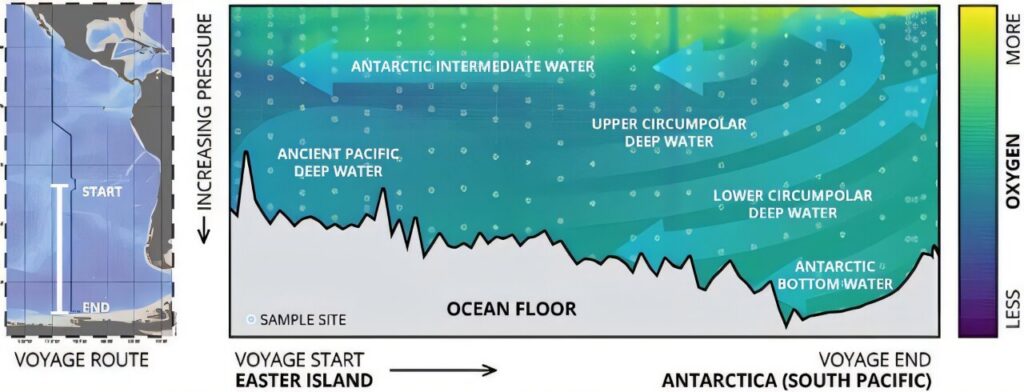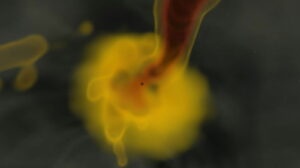
A groundbreaking study published in the journal Science has uncovered the significant role deep ocean currents, known as global overturning circulation, play in shaping the diversity and function of microbial communities across the South Pacific Ocean. This research, spearheaded by scientists from the J. Craig Venter Institute (JCVI), UC San Diego’s Scripps Institution of Oceanography, and the University of California Berkeley, provides the most detailed genetic map yet of how these communities are structured by the movement of ocean water.
The research team embarked on a voyage from Easter Island to Antarctica, collecting over 300 water samples from various depths to gain a comprehensive understanding of microbial life. This extensive sampling has shed new light on how these populations are layered, each employing survival strategies tailored to their specific environments.
Unveiling the Deep Ocean Ecosystem
According to Bethany Kolody, the study’s lead author and a postdoctoral researcher at Cal, winds and storms only affect the ocean’s surface up to about 500 meters (1,640 feet), a fraction of the ocean’s total depth of 4,000 meters (13,125 feet). Beyond this depth, currents driven by differences in water temperature and salinity create the global overturning circulation, a conveyor belt that transports water—and the microbes within it—across vast distances and depths.
“Until now, it was unclear whether these water masses also served as distinct microbial ecosystems,” Kolody stated. “We can now answer that question with a resounding, ‘yes.'” The study identified six distinct microbial “cohorts,” three of which correspond to depths and the others aligning with major water masses: Antarctic Bottom Water, Upper Circumpolar Deep Water, and ancient Pacific Deep Water.
The Prokaryotic Phylocline
The researchers discovered a striking pattern of microbial diversity increasing sharply about 300 meters (1,000 feet) below the ocean surface in a zone termed the “prokaryotic phylocline.” This layer marks a transition from low-diversity surface waters to the rich microbial communities of the deep ocean.
“The study provides a baseline for how microbial ecosystems are organized under current ocean conditions,” said Andrew Allen, senior author of the study and a microbial oceanographer at JCVI and Scripps Oceanography.
Mapping Microbial Functionality
Beyond taxonomy, the research team also mapped the functional potential of microbial communities, identifying ten “functional zones” based on the presence of key metabolic genes. These zones correspond to oceanographic features such as upwelling regions, nutrient gradients, and oxygen minimum zones.
Surface zones were found to be rich in genes for light harvesting, iron acquisition, and photoprotection—traits essential for life in the sunlit upper ocean. In contrast, deeper zones featured genes for breaking down complex organic molecules, surviving low oxygen, and enduring environmental stress.
Implications for Climate Change
Microbes play a crucial role in the ocean’s carbon cycle by converting carbon dioxide into organic compounds, recycling nutrients, and helping trap carbon in the deep sea. Understanding how their communities are structured by ocean circulation is vital for predicting how climate change might alter these processes.
“As climate change impacts global overturning circulation, the distribution and function of these microbial communities could shift, with unknown consequences for global carbon cycling,” Allen explained.
Future Directions and Global Monitoring
The study’s authors advocate for incorporating molecular sampling into global ocean monitoring programs like GO-SHIP. By pairing genomic data with physical and chemical measurements, scientists can build a global, species-resolved atlas of ocean life—essential for understanding and protecting the planet’s largest ecosystem.
“This study is a reminder that life in ocean ecosystems is, in part, governed by fundamental patterns and processes that are unknown to us,” Allen noted. “Seeing and understanding them requires that we examine them more sensitively, carefully, and thoroughly.”
The breakthroughs reported in this study result from a truly interdisciplinary effort involving physical oceanographers, biological oceanographers, and genome biologists working closely together. As the scientific community continues to unravel the mysteries of the deep ocean, such collaborative efforts will be crucial in advancing our understanding of this vital component of Earth’s biosphere.





